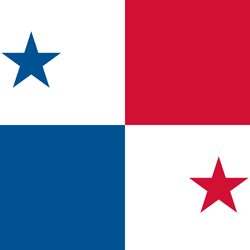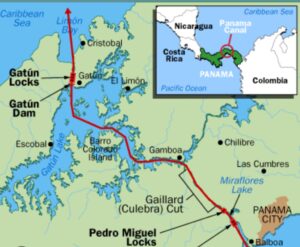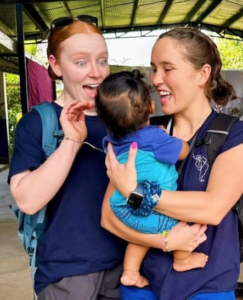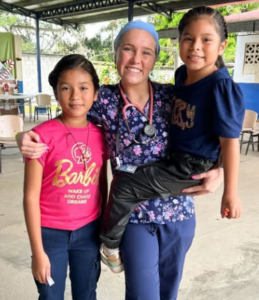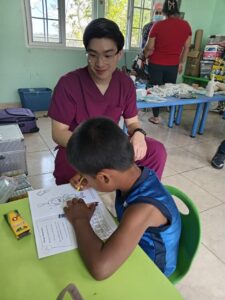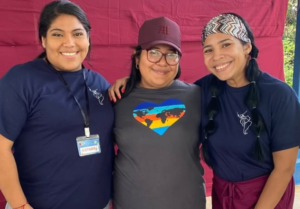About Panama
Panama (thought to mean “an abundance of fish”) is a Central American country bordered by the Pacific Ocean, the Caribbean Sea, Colombia, and Costa Rica. Panama has been a stable democracy since 1990. Prosperous and progressive, Panama has the second largest Central American economy. While Panama is known for the Panama Canal and its tropical fruit exports, tourism is becoming an important industry.
Twenty percent of Panama’s land is protected, belonging to the tribes of its indigenous people – one of the largest percentages in the world.
The unemployment rate in Panama is 7.4%, and 11% of the population lives in poverty – on less than one dollar a day. Many of the poor are immigrants from Colombia, Venezuela, and Cuba. These are the communities where ISL volunteers serve
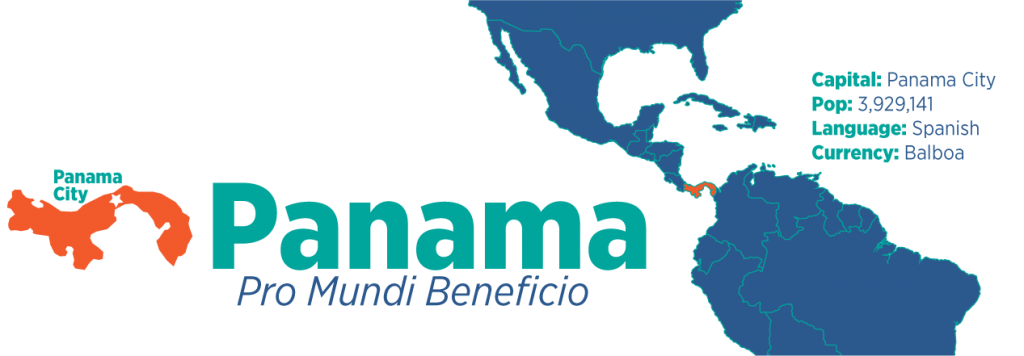
Where We Serve in Panama
ISL’s service learning volunteers in Panama seek to serve as many of the country’s poor as we can, serving in both rural, semi-rural and urban areas.
In rural and semi-rural areas, poverty is evident by the limited access to health services, constraints in transportation, and lack of economic resources. People in these communities are often exposed to infectious diseases, even though the housing in these areas is a little better than that of the poverty stricken in urban areas. Some, however, still live in houses made of mud. The population in rural areas is a mixture of Latino and indigenous peoples, who follow the crop harvests for work.
In urban areas, poverty is more evident and social risks to children and adults are greater, as many of them are exposed to violence, drug addiction, alcoholism, and other crimes.
Our Partnerships
As with any great work, it takes great relationships to get the job done. That’s why ISL Panama has partnered with nonprofits, hospitals, governmental and religious groups, and institutions to better serve the underprivileged of Panama.
Hogar de las Niñas de la Capital
A home for girls in Las Cumbres, Panamá
Fundación NUTEJE
Soup kitchens and a school in Las Garzas de Pacora, Colón, and Chiriquí
Fundación Juntos Podemos
An elementary school for a Shanty Place call Curundu.
Escuela de Pajonal, Pajonal, Coclé
We provide medical and dental service to students.
Escuela de Rincón de las Palmas, Coclé
We provide medical and dental service to students.
Asociación de Mujeres Ngobe Bugle
We have a partnership with them to provide health care to the community of Quebrada de Guabo in the Reserve in Chiriquí.
San Martín de Porres Parrish, Cerro Batea, San Miguelito Panamá
Nuestra Sra. Del Rosario Parrish, Torrijos Carter, San Miguelito Panamá
Fundación Spay Panamá, Betania, Panamá
FUNDACION VALORATE
Local organization to attend kids with autism and ADHD
ALDEAS SOS – PANAMA- COCON – COCLÉ
Orphanage that attends kids and teenagers
UCLA- UNION DE CAMPESINOS DEL LAGO ALAJUELA
We provide medical and dental service to the community
HOGAR LUZ Y VIDA
Elderly home at Panama City
PANAMA NORTE MINISTERY HEALTH REGION
We provide medical and dental service to the communities of this region
What to Expect as a Service Learning Volunteer
Volunteers arrive for service in Panama via the Tocumen International Airport (PTY), which is located 15 miles from downtown Panama City. After going through Customs and retrieving luggage, volunteers are met by an ISL staff member. They are then transported by taxi, van, or bus (arranged and paid for by ISL) to their hotel or guest house in the province closest to their work site.
Airport to hotel travel time varies from 20 minutes to 2 hours. Daily travel time from housing to work sites varies from 15 to 45 minutes. On recreation days, travel may take up to a maximum of two hours. Housing locations may change as volunteers move to a new work site or as they travel to their recreation day location.
Cultural Exploration
With ISL Panama, you’ll have many opportunities to experience the culture of those you serve as volunteers. Here are some of the possibilities:
Cooking Classes
Learn how to make one of many famous and delicious Panamanian dishes.
Dance Classes
From Salsa, Merengue, and Bachata to Panamanian folk dance, this is an excellent opportunity to learn the basics of Latin dance.
City Tours
Walk around the city and explore parks and architecture, from colonial times to very modern buildings.
Music Workshop
Learn about traditional instruments, enjoy a moment to connect with music and learn how to meditate with the sounds.
Local Handcraft Tour
Learn about local handcrafts and study the materials used to make them at the craft market.
Traditional Dress
Try on the Panamanian traditional dress called Pollera for girls and Montuno for boys. Take photos for an unforgettable memory of your visit.
Casa Gongora visit
Visit a 17th century colonial period house called Casa Gongora. Panamanian artists hold art expositions there as well.
Recreation
After long days of service work, here are some of your Recreation Day options.
Panama Canal Visitor Center
The Miraflores Visitors Center (CVM) is located on the east side of the Miraflores Locks. It allows visitors to observe transiting vessels from the distance of only a few yards and to learn about the various operations of the Panama Canal, the history of its construction, its participation in the world markets, and the importance of its watershed.
Cost: $30.00 for foreign students with University ID
Summit Garden and Zoo
A great introduction to the plants and animals of Panama’s rain forests, Summit Garden was founded by the Panama Canal Company in 1923 as a research station for the tropical flora of Panama. Through this research teak was introduced to the American continent. Now a zoo and a botanical garden, some of the attractions are the harpy eagle, the national bird of Panama, the Suicide tree and the Cinnamon tree.
Cost: $5.00
Ancon Hill
This 600 foot hill is the highest and most popular viewpoint in Panama City, with views over the Panama Canal, city center and Casco Viejo, the old town region. The road up the hill, though somewhat steep, is suitable for hikers of all abilities and it is not uncommon to see sloths, armadillos, coatimundis and deer along the way.
Cost: Free
Panama Viejo
Panama Viejo (Old Panama), a World Heritage Site, contains the remaining ruins of the first Spanish city on the Pacific coast of the Americas. Founded in the 1500’s, the city was the launching point of expeditions that conquered the Inca Empire in Peru. For 150 years it flourished as Spain exported Peruvian gold and silver to Europe via Panamá. Plagued by fire and earthquakes, it was finally decimated in the 1600’s by the pirate Henry Morgan, who sacked the city. A visit to the museum before touring the ruins is recommended.
Cost: $6.00 per person
Metropolitan Nature Park – Cieneguita Trail
This park is one of the world’s few wilderness areas within the boundaries of a capital city. Follow the trail as it winds through the rain forest, keeping an eye out for agoutis (large guinea pig-like burrowing rodents) and your ears perked for tamarins, tiny monkeys that sound like birds.
Cost: $4.00
Metropolitan Nature Park – Canopy Crane
An international team of scientists from the Smithsonian Tropical Research Institute set up a crane in this park to study the forest canopy, where most of the rain forest species live. Currently there are 12 cranes in the world used for this purpose, two of which are in Panama; you can ride one through a guided tour.
Cost: $$$ (expensive)
Mi Pueblito
Mi Pueblito, meaning “my little village,” is a mock village with life-sized replicas of colonial, Afro-American and indigenous dwellings, showcasing the diverse customs and traditions of Panamá–a great option for photos and a good place to buy handcrafts.
Cost: Free
Casco Viejo
Casco Viejo, the historic district of Panama City, is a World Heritage Site. Completed and settled in the 1600’s, it was built after the original Panamá City was destroyed by pirates.
Cost: Free
Cinta Costera
This bay-front area with unbeatable views is a favorite place for Panamanians and foreigners to stroll or jog along the water. Watch ships line up for passage through the Panama Canal and enjoy an impressive view of Panama City, as well.
Cost: Free
Taboga Island
Isla Taboga is part of an island chain 12 miles south of Panama City. The largest island in this chain, Isla Taboga dots the Pacific side of the Panama Canal and boasts the closest beaches to Panama City. Besides relaxing and enjoying the beach you can walk through its quaint and colorful town, hike to the top of El Cruce for an amazing view, go snorkeling, or take an historical tour.
Cost: Ferry-Boat Fares – $17-$20 adults
Amador Causeway
The Amador Causeway connects three islands to the mainland near the entrance to the Panama Canal. From the causeway, there is an amazing view of Panama City and the Bridge of the Americas. Many Panamanians spend their weekends here jogging, riding a bicycle or rollerblading, and enjoying a meal in one of the many island restaurants.
Cost: Bike rentals – $3-$18 USD per hour
Kuna Yala Day Tour
Kuna Yala is a collection of some 365 islands (one for each day of the year) where you can swim and snorkel. The islands of Kuna Yala have been formed by an accumulation of coral and are covered with palm trees and indescribable white sand beaches.
You’ll love walking along the white beaches, swimming in the crystalline water, relaxing in a hammock in the shade of the palm trees, and listening to the sound of the waves and ocean breeze.
Cost: $130.00 per person – a full day tour package that includes: breakfast, lunch, round trip boat and jeep transportation, entrance fee to the region of Kuna Yala, beach access, and snorkeling gear.
Embera Indigenous Village
Includes visit, waterfall, boat, lunch and traditional workshop.
Cost: $35 full day tour
Lodging
Whether lodging at a hacienda on the beach of the Sea of Cortez in Puerto Penasco, Mexico; a walled convent in the heart of Alajuela, Costa Rica; or an apartment situated above the bustling metropolis of Santo Domingo, Dominican Republic, ISL’s volunteer lodgings are unique and carefully chosen based on very important criteria.
Accommodations are safe, clean, and within a reasonable driving distance to service sites and recreational opportunities. Volunteers are provided their own bed, easy access to restrooms and showers, as well as meeting spaces for training and fellowship. Many ISL accommodations are unique and may include retreat houses, guest houses or home stays, all of which provide a distinctive cultural experience. ISL Country Coordinators will provide a description of your specific lodging in the Final Trip Document uploaded to your My ISL Portal prior to your departure.
Casa de Retiro Espiritual Monte Alverna, Betania, Panamá,
https://www.facebook.com/casaderetiro.montealverna
Fundación Alternativa, Coclesito, Colón
https://www.facebook.com/fundacion.alternativa
Hotel Roma, Panamá
http://www.hotelromaplaza.net/pa
Hotel Ojos del Río
http://hotelojosdelrio.com
La iguana Ecor Resort, Coclé
http://hotelojosdelrio.com
Hotel Santa Fe, Veraguas
http://www.hotelsantafepanama.com
Hotel Lleras, David, Chiriquí
http://www.lleraspanama.com
Hotel Residencial Cervantes, David, Chiriquí
http://www.hrcervantes.com
Hostal Llano Lindo, Volcán, Chiriquí
http://www.hostalllanolindo.com
Country Coordinator Spotlight: Mariluz Portugal
International Service Learning (ISL) is very proud of their Country Coordinators and we would like for you to get to know them, before you visit their beautiful country. All of our Country Coordinators are hardworking, passionate individuals who enjoy serving their communities and working with ISL volunteers, and they all have their own very unique stories.
Where is she from? Where has she lived?
Mariluz was born in the Herrera Province in Panama City. She moved to Penonomé, a city adjacent to Panama City (the capital of Panama), and later she lived in the capital.
What does she love most about her country?
What she likes most about Panama is the cultural diversity. You can find different kinds of culture in just one nation because of the variety of countries that are represented in Panama.
What is her family like?
Mariluz is married and she has a ten-year-old child.
Where was she raised? What was her childhood like?
She lived in Penonomé for almost all of her childhood and youth. More than anything, she says that she was one of those kids who went to school every single day, including weekends and in the summer. She participated in many extracurricular activities, and even though she says she wasn’t sporty, she was very intellectual.
What was the most impactful moment for her during her education?
The most impactful moment for Mariluz was in high school when she was studying for her Business Diploma with an emphasis in Corporate Management. This allowed her to study Tourism, something that was interesting to her. This ended up being very important for her as it allowed her to see many places in her country and know how to show these things to people who came to visit Panama.
What has she worked in besides being a Country Coordinator?
She says that in college, they are given the opportunity to do a certain amount of internship hours, and those hours helped her to get a job. She worked in the hotel industry, as a waitress and receptionist, and in travel agencies doing tours and transfers. One of these agencies was Sunwing, a Canadian travel agency, where she worked as an airport assistant. Nowadays she works in an official University and is pursuing a postgraduate in higher teaching and with this she will be able to become a teacher at the university level.
When did she realize what her calling was?
Mariluz realized what her calling was when she started college. She learned about organizing tours, the logistics that accompanied them, and everything that she needed to know in order to be able to successfully perform her vocation. At ISL, she is able to put into practice everything she learned in school. Even though the ISL teams aren’t tourists, she is able to apply the logistics and organization that she learned in college.
How did she become an ISL Country Coordinator?
Mariluz started in 2012 as a bilingual assistant with a friend who did it as well. She helped with six groups until they needed someone to be an Assistant Team Leader. Later, she was promoted to be a Team Leader, and in that role she led multiple groups, which has greatly helped her in her job now. She helped the previous Panama Country Coordinator to make contacts in the different places where ISL works, since she had those skills. When the International Director started to do interviews for the new Panama Country Coordinator role, Mariluz turned in her resume to interview for the position. And now, she is the Country Coordinator in Panama!
How long has she worked with ISL?
Mariluz has worked with ISL for almost 12 years.
A brief summary of what she does as a Country Coordinator:
As a coordinator, she has access to the database in order for her to put together the details for the teams who are about to come to her country. She does an evaluation of all the communities in the database to see which to assign depending on the amount of volunteers and the type of program (Global Health, Dental, etc.). She makes contacts and sends notes for the health centers, schools, colleges, and community leaders. Also, she plans the budgets, the itineraries, and the staff team that will work during those dates. She keeps in contact with the team leaders and the assistants in order to keep them up to date and to share information about the organization where they will be working.
What inspires her most about what she does?
What most inspires Mariluz is being able to help others while doing what she loves. Many people have the skills to do something for others but do not have the means, but ISL gives her the opportunity to do it. She says that there are families who do not have the money or the resources to take their children to a clinic and they don’t know that the program exists, but International Service Learning gives them access to health and medicine. It makes her happy and thankful to be able to help others through this kind of work and this kind of organization.
Panama's Staff
We love our staff and we are positive that you will too! Each staff member is professional, courteous, and has the same passion as you do: to serve others.

